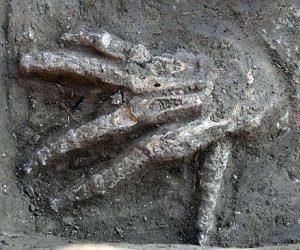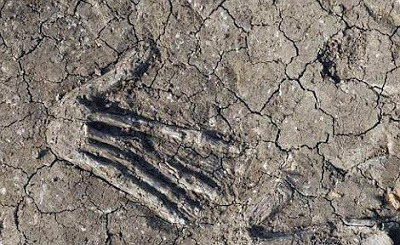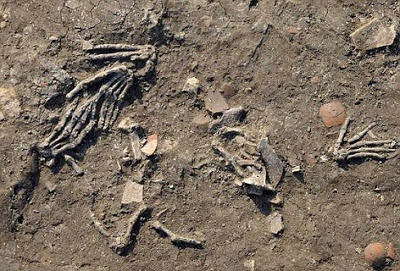Scary Archaeology Finds, The Pits Of Severed Hands in Ancient Egypt Palace

Archaeologists recently made a discovery that looks like it is straight out of a Scary film: over a dozen severed hands covered in, and around, an ancient palace in modern day Egypt.

The archaeologists have uncovered the skeletons of 16 human hands buried in four pits. 2 of the pits, located in front of what is believed to be a throne room, hold one hand each.
Two different pits, constructed at a slightly later time in an outer space of the Royal palace, contain the 14 remaining hands.
They are all right hands; there are no lefts.
“Most of the hands are quite large and some of them are very large,” Manfred Bietak, project and field executive of the excavations, told LiveScience.
The finds, made in the Nile Delta northeast of Cairo, go back about 3,600 years to a time when the Hyksos, a people believed to be originally from northern Canaan, controlled part of Egypt and made their capital at Avaris an area known today as Tell el-Daba.
At the time the hands were buried, the Royal palace was being used by one of the Hyksos rulers, King Khayan.
And all hands found are very large.
The group of archaeologists who made the discovery have determined that the bones all date back to about 3,600 years ago – an indication that they all came from the same ceremony.
All of the hands appear to be unusually large, and they are all right hands. They were sorted into 4 different pits within what the scientists believe was the royal Hyksos compound.
Manfred Bietak, the Austrian archaeologist in charge of the excavation of the ancient city of Avaris, explained the to journal Egyptian Archaeology that the hands seem to support stories found in ancient Egyptian writing and art.

Despite the fact this would be the first physical evidence that this is true, the older sources seem to indicate that soldiers would cut off right hands and, in return, claim a bounty of gold.

Now the main question is why they would do that. Of course, cutting off the hand was a symbolic means of removing an enemy’s strength, however the meaning is likely also supernatural since this was done at a holy site and a temple as part of a ritual.
Strangely, the hands were not at all uniformly distributed between the pits. Almost all of them were in two of the pits, while the other 2 pits only held one hand each.
So far there is no evidence that would show what type of people these hands belonged to, but it is most likely that they were native Egyptians or from the people of the Levant.
When asked to clarify why he thought this ritual may have been carried out, Bietak said “You deprive him of his power eternally.
Our proof is the earliest evidence and the only physical evidence at all. Each pit represents a ceremony.”The 2 pits that each contain one hand were positioned directly in front of a throne room.
This section of Egypt was once controlled by an occupying force that most of historians believe originally were Canaanites, so there may be a connection to the invasion.
The other hands, which may have been buried at the same time or at a later date, are on the outer grounds of the Royal palace.
Now the only question is, why? What amount do we know, and what is speculation? To be honest, there is a lot more that should to be researched, but many signs point to this being some sort of ritual to a god or gods.
The way that the hands were abnormally large indicates that these people were specially selected, which is more characteristic of a sacrifice than killing an invading army.
The fact that two hands were buried separately may indicate that these contributions were intended to be especially satisfying to the gods. Finally, these sacrifices are not surprising in an area that faced foreign invasion.
Egyptians would often call upon their gods to punish invading armies with plagues, starvation, or general misfortune. It is possible that these sacrifices were part of a curse against the invading armies.